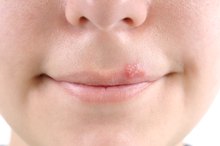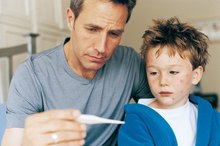Cold Sore Stages
Cold sores, often called fever blisters, usually occur on the lips or around the mouth 2. Caused by the herpes simplex virus, or HSV, and transmitted through skin contact with an infected person, this infection spreads easily. Cold sores generally follow the same stages: tingling, blistering, weeping, crusting and healing 2.
If you are experiencing serious medical symptoms, seek emergency treatment immediately.
Tingling
The first stage of cold sore development usually presents as a burning, tingling or itching sensation around the lips or nose. The tingling stage, also called the prodromal stage, lasts for one to two days. The tingling spot may swell, turn red or feel sore. The tingling stage is the best time to treat a cold sore. No cure exists, but pain management remedies do work as treatment. Treatment options include physician-prescribed antiviral medications, over-the-counter creams and ointments and icing to numb the affected area.
- The first stage of cold sore development usually presents as a burning, tingling or itching sensation around the lips or nose.
Blistering
Stages of Cold Sores
Learn More
Within 12 hours of the tingling stage of a cold sore, the blistering stage occurs, bringing with it a small, red area with fluid-filled blisters. One blister may appear, but the possibility exists of several blisters developing. The duration of the blistering stage is usually two days.
Weeping
Following the blistering stage comes the one day long weeping stage, also called the ulcer stage. As sores that developed during the blistering stage grow, they rupture and leak fluid containing infectious viruses, making this a highly contagious stage. The red sores may become gray at this point. The weeping stage is often the most painful.
- Following the blistering stage comes the one day long weeping stage, also called the ulcer stage.
- As sores that developed during the blistering stage grow, they rupture and leak fluid containing infectious viruses, making this a highly contagious stage.
Crusting
Herpes Symptoms on the Labia Minora
Learn More
During the crusting stage, the cold sore develops a scab which may crack and bleed. Additional scabs form during the next two to three days, eventually shedding and leaving a red, sensitive spot.
Healing
The final stage, the healing stage, returns the area infected by a cold sore to its original state. Permanent scarring rarely occurs. However, the virus continues to live in your nerves. Cold sore outbreaks often occur during times of stress or sickness -- those prone to cold sores understand their triggers as an avoidance mechanism 2. Physicians advocate a healthy lifestyle, as well as use of sunblock and moisturizer on the lips.
- The final stage, the healing stage, returns the area infected by a cold sore to its original state.
Related Articles
References
- MedlinePlus: Cold Sores
- Ramchandani M, Kong M, Tronstein E, et al. Herpes Simplex Virus Type 1 Shedding in Tears and Nasal and Oral Mucosa of Healthy Adults. Sex Transm Dis. 2016;43(12):756-760. doi:10.1097/OLQ.0000000000000522
- Institute for Quality and Efficiency in Health Care (IQWiG). Cold sores: Overview. 2018.
- Montgomery-cranny JA, Wallace A, Rogers HJ, Hughes SC, Hegarty AM, Zaitoun H. Management of recurrent aphthous stomatitis in children. Dent Update. 2015;42(6):564-6, 569-72. doi:10.12968/denu.2015.42.6.564
- Krissel JD, Bhatia A, and Thomas A. Cold sore susceptibility gene-1 genotypes affect the expression of herpes labialis in unrelated human subjects. Hum Genome Var. 2014; 1: 14024. doi:10.1038/hgv.2014.24
- Fatahzadeh M and Schwartz RA. Human herpes simplex virus infections: Epidemiology, pathogenesis, symptomatology, diagnosis, and management. J Am Acad Dermatol. 2007;57(5):737-63. doi:10.1016/j.jaad.2007.06.027
- Formica M, Kabbara K, Clark R, Mcalindon T. Can clinical trials requiring frequent participant contact be conducted over the Internet? Results from an online randomized controlled trial evaluating a topical ointment for herpes labialis. J Med Internet Res. 2004;6(1):e6.
- American Academy of Dermatologists. Cold sores: Overview.
- American Academy of Dermatologists. Cold sores: Signs and symptoms.
- American Academy of Dermatologists. Cold sores: Tips for managing.
Writer Bio
Nicki Wolf has been writing health and human interest articles since 1986. Her work has been published at various cooking and nutrition websites. Wolf has an extensive background in medical/nutrition writing and online content development in the nonprofit arena. She graduated with a Bachelor of Arts in English from Temple University.






